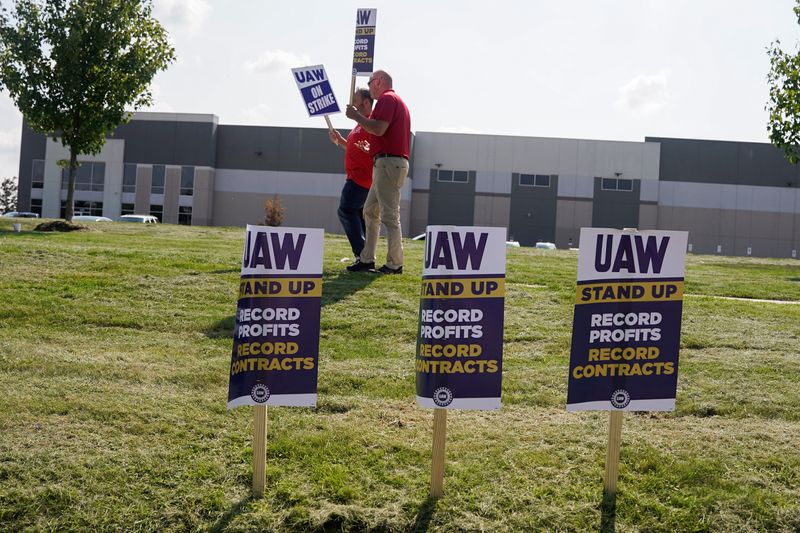(Reuters) - The United Auto Workers (UAW) union on Friday refrained from expanding its coordinated strike against the Detroit Three automakers but warned it may now call for more strikes at anytime and not wait for a Friday.
It is a change in strategy to force General Motors (NYSE:GM), Ford Motor (NYSE:F) and Stellantis to improve their offers, as the first-ever simultaneous labor action against the companies enters its 29th day.
The automakers, like their global counterparts, have been focused on cost reductions, which in some cases include job cuts, to help accelerate a shift to electric vehicles (EVs) from gasoline-powered vehicles.
WHO IS THE UNION NEGOTIATING WITH?
The UAW, which represents 46,000 GM workers, 57,000 Ford employees and 43,000 Stellantis workers, kicked off negotiations with the companies in July.
The union historically has picked one of the Detroit Three to negotiate with first as the so-called target that sets the pattern on which subsequent deals are based. This time, union President Shawn Fain targeted all three companies simultaneously.
Contract talks between the UAW and the Detroit automakers in past years had gone on until the strike deadline and beyond. A Reuters/Ipsos poll found significant support by Americans for the striking auto workers.
HOW WIDESPREAD IS THE STRIKE?
The strike has now spread to over 34,000 workers, or just over one-sixth of the workers employed by the Big Three. It initially targeted three assembly plants in Michigan, Ohio and Missouri that build the Ford Bronco, Jeep Wrangler and Chevrolet Colorado, along with other popular models.
The second round of strikes expanded to 38 locations across 20 states in all nine regions of the UAW, focusing on parts distribution centers.
On Wednesday, Fain changed tactics by ordering a sudden walkout at Ford's Kentucky Truck heavy-duty pickup and large SUV factory, the automaker's largest, most lucrative single operation globally.
Prior to that, he had used a livestream video on social media to announce strike expansions on Fridays.
WHAT ARE THE CURRENT OFFERS AND WHAT DOES THE UAW HAVE TO SAY?
Ford has offered a 23% wage hike through 2028, where as Stellantis has offered 21.4% hike. GM has offered an about 20% raise. But the union has demanded a 40% wage hike, including a 20% immediate increase, and improvements in benefits.
Fain also wants workers at EV battery plants to be covered by union contracts. The union is in discussions with GM about the parameters of a deal to include battery plant workers under a master labor agreement.
Ford is also working with the UAW on a way to bring workers at joint venture EV battery plants into the UAW-Ford agreement.
WHAT IS AT STAKE?
A full strike would hit earnings at each affected automaker by about $400 million to $500 million per week assuming all production was lost, Deutsche Bank (ETR:DBKGn) previously estimated.
In fiscal 2019, GM's fourth-quarter profit took a $3.6 billion hit from a 40-day UAW strike.
Morgan Stanley (NYSE:MS) analyst Adam Jonas estimated on Sept. 21 that a full month of lost production would cost the three automakers $7 billion to $8 billion in lost profits.
WHAT ARE THE UNION'S DEMANDS?
The UAW is pushing automakers to eliminate the two-tier wage system under which new hires can earn far less than veterans.
Fain has said repeatedly that the union will push to restore pay improvements tied to the cost of living and retiree benefits cut during the 2008-2009 economic crisis.
The UAW wants strong salary increases, given the financial success of the automakers, citing generous executive payouts and large U.S. federal subsidies for EV sales.
The union also wants defined benefit pensions for all workers restored, 32-hour work weeks, job security guarantees and an end to the use of temporary workers.
WHAT DO AUTOMAKERS WANT?
The Detroit Three want to close the cost gap they have with foreign automakers with non-unionized U.S. factories.

Ford sources estimate that their U.S. labor costs are $64 an hour, compared with an estimated $55 for foreign automakers and $45 to $50 for EV leader Tesla (NASDAQ:TSLA).
The companies also want greater flexibility in how they use their U.S. workforce to increase efficiency and cut costs as the industry shifts to EVs.